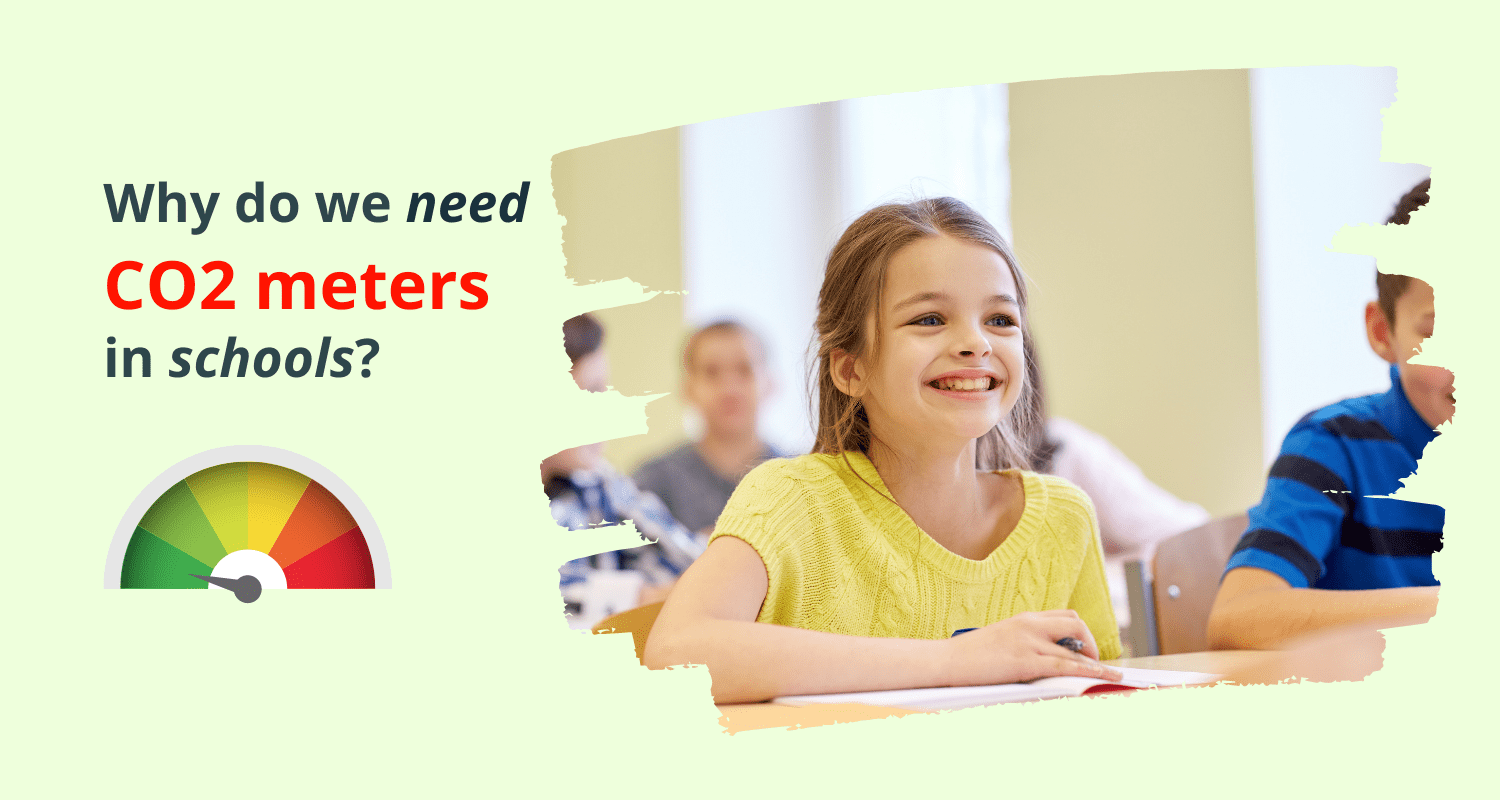Amidst the Covid-19 pandemic, many European governments are seriously considering allocating CO2 meters for schools. Through some public funding, schools in Belgium, Latvia, and the United Kingdom will be equipped with smart sensors to monitor CO2 levels and improve the air quality in classrooms. The Netherlands, through its SUVIS program, will release some public money to municipalities to fund local schools for the renovation efforts.
What is a CO2 meter?
A CO2 meter is used to accurately measure the concentration of CO2 in the air in order to track air quality indoors and outdoors. Using a CO2 meter, you can monitor ppm rate – the air particles per million. Then, based on the score you see, you can better manage indoor climate and decide whether additional ventilation is needed.
A CO2 meter does a great job in limiting viruses and bacteria from spreading fast throughout the building. Basically, poor air quality is the cause of minor health problems such as mild fatigue and headaches. And whereas low productivity does not pose a significant health hazard, being exposed to poor air for a long time can lead to serious health conditions.
The CO2 sensors indicate very accurately what exactly the concentration of CO2 is in a particular room. In the ideal situation, the amount of CO2 should be between 500 and 800 parts per million. If the concentration of CO2 is too high, the CO2 meter will alarm you.
What is a CO2 meter used for?
A CO2 meter will ensure that there is enough clean air in any indoor space. With a CO2 meter, you monitor the quality of the air and you can ventilate rooms more consciously. You will be in a better place managing building ventilation based on the equipment and options you have in the facility.
With the help of a CO2 meter, you will be immediately informed in case there is a too high concentration of CO2 in the air, or in case the mechanical ventilation systems are not functioning properly. In fact, according to the Dutch Health Council, the CO2 content is indeed an excellent indicator of air quality.
Why do we need CO2 meters for schools?
- The well-being of students, tutors, and other school employees
Measuring CO2 is important for the vitality and well-being of teachers and students. If the CO2 level is too high, it can greatly affect and worsen the cognitive performance and well-being of those indoors. According to experts, the air quality in classrooms can be generally improved to more satisfying levels. High CO2 concentration leads to fatigue, stress, headaches, and less focus.
- Covid-19 and other viruses
As we already know, clean air is the arch-enemy to airborne viruses such as the Covid-19. As CO2 meters in schools can alert about poor air quality, there would be fewer infected students and tutors. Along with the long-term health negative effects that Covid-19 might impose, the lack of proper school schedule and attendance might negatively affect student educational development. Whereas online classes are a good substitute to cope with the closed schools, nevertheless, remote classes cannot suffice in many cases.
![Infographics: 5 complaints due to hight CO2 in schools CO2 Meters For Schools - the Ultimate Guide [Infographics: 5 complaints due to hight CO2 in schools]](https://recheck.io/blog/wp-content/uploads/2022/01/co2-health-complaints.png)
- Health hazards
If there are no CO2 meters in schools and there is insufficient ventilation in the building, a high concentration of CO2 may lead to various health problems. Besides the fact that learning performance can worsen, complaints about headaches and alignments related to the eyes, nose, and respiratory tract can occur. Allergies and asthmatic symptoms can also worsen.
The five most common complaints due to high CO2 in schools include fatigue and headache, increased risk of asthma attacks, worsened allergies, sore throat, and spread of bacteria and viruses.
CO2 meters for schools – how many do you need
Assessing your situation, you naturally may be asking yourself how many CO2 sensors will be needed to monitor your school. And the truth is that it is vital to measure all rooms and spaces separately. You must know that in reality, very different CO2 levels can develop in otherwise identical rooms. That is why it is important to monitor each (classroom) room separately. Furthermore, besides the classrooms, you need to take into consideration auditoriums, school canteens, and halls and install CO2 meters separately.
CO2 meters for schools funded by SUVIS
Recently, the Dutch government started the Specific benefit for ventilation in schools (SUVIS), which is a monetary benefit for municipalities to improve the indoor climate in school buildings. The grant scheme covers renovation and installation costs for CO2 meters for schools.
The Specific Benefit Ventilation in Schools (SUVIS) scheme is a grant released to municipalities to improve the indoor climate of existing school buildings. This benefit can be applied to cover renovation costs and it amounts up to 30% of all renovation costs, with a maximum threshold based on the number of students.
In addition to improving the air quality, the SUVIS regulation also requires daily CO2 measurements to be made available, and an energy-monitoring system.
Who can benefit from the SUVIS scheme?
The scheme was created for existing primary and secondary school buildings in the Netherlands. Municipalities apply for the grant in collaboration with local school boards. The subsidy can be requested for schools that want to renovate their facilities to improve the indoor.
Only existing schools can apply for the grant, which excludes new school developments. Furthermore, educational facilities as agricultural training centers or vertical schools are not included in the SUVIS plan. The same is applied to sports halls or childcare facilities within the school.
What CO2 meters are suitable?
The carbon dioxide meters must meet the following requirements:
- Real-time monitoring of the indoor climate (including CO2, temperature, and humidity).
- Reports available per day, week, and year.
- The data must remain available for at least one year
- Insights on building improvements with regard to the indoor climate.
![Infographics: What CO2 meters are suitable for the SUVIS scheme CO2 Meters For Schools - the Ultimate Guide [Infographics: What CO2 meters are suitable for the SUVIS scheme]](https://recheck.io/blog/wp-content/uploads/2022/01/co2-meters-benefits.png)
SUVIS – Application Requirements
The specific grant is intended for projects where schools are planning renovations inside the building. Besides CO2 meters for schools, school managers must also undertake some energy-efficient measures to improve the indoor climate. Upon regulation, schools must undertake measures to achieve the following goals:
- A CO2 level of up to 1,200 ppm, in school buildings built before April 1, 2012;
- A CO2 level of maximum 950 ppm, in school buildings built on the basis of an environmental permit for building applied for on or after 1 April 2012;
Schools must ensure that they will be: - Installing carbon dioxide meters in every classroom in the school building. Additionally, the carbon dioxide meters must comply with the obligations referred to in Article 3.5 of the 2012 Building Decree Regulation. The CO2 meters in schools should allow for monitoring of the data for at least one year.
- Installing an energy-efficiency monitoring system with daily, weekly, and yearly reporting capability.
- The money received under SUVIS can also be used for other energy-saving measures which must then limit energy consumption and respectively CO2 emissions.
- Construction activities must start between October 1st, 2020, and August 31st, 2022. Renovation projects must be completed by August 31, 2024, at the latest.
![CO2 Meters For Schools – the Ultimate Guide [Infographics: What CO2 meters are suitable for the SUVIS scheme?] CO2 Meters For Schools - the Ultimate Guide](https://recheck.io/blog/wp-content/uploads/2022/01/CO2-acceptable-levels.png)
How can you apply for the SUVIS scheme?
Schools cannot independently and individually apply for a SUVIS grant. School managers can apply only through the local municipalities. The municipality applies for the one-off benefit per project and the subsidy amounts to no more than 30% of the overall costs. Also, be advised that the maximum allowance is based on the number of students.
The maximum allowance per project:
- €150,000 for one or more school buildings with a total of fewer than 250 students
- €210,000 for one or more school buildings with a total of 250 to 500 students
- €420,000 for one or more school buildings with a total of 500 to 1,000 students
- €800,000 for one or more school buildings with a total of 1,000 to 2,000 students
- €1,000,000 for one or more school buildings with a total of 2,000 students or more
A municipality applies with a project that includes one or more school buildings in the same location. There is no limitation as to the number of submitted requests. If approved, the municipality will receive a maximum of 30% of the total costs and a maximum of € 1 million in total per application.
Upon submitting their project, schools must provide the following input:
- address details of the school/schools;
- a statement in which you indicate that the ventilation is not sufficient;
- an overview of the measures and the air exchange capacity, or CO 2 concentration after the measures have been taken;
- the number of students on October 1, 2020;
- a budget;
- a time schedule of the work;
- project plan






